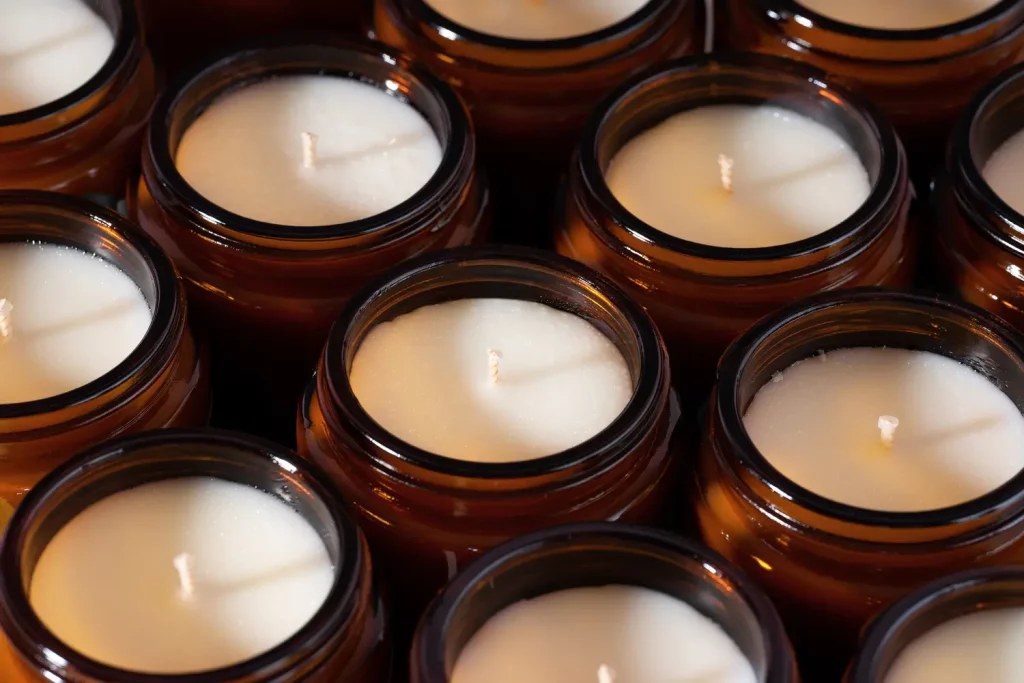Have you ever noticed a white, frosted appearance on your scented candles? Fear not, this phenomenon, known as “frosting” or “crystallization” is perfectly normal, and doesn’t affect the candle’s performance. This article will talk about what frosting is, and how you can potentially fix it.
What is Candle Frosting?
Candle frosting is the process where the wax starts cooling down, and then tries to go back to its natural form, and in return, creates crystals. This is especially the case with vegetable-based waxes like soy wax. These crystals create a white, frosted texture on the candle’s surface, whether it is on the top, or on the sides.
Why is Soy Wax Prone to Frosting?
Soy wax is a popular choice for candle makers due to its eco-friendly nature and clean burn. However, unlike paraffin wax, soy wax is polymorphic. This means it can form different crystal structures at varying temperatures. These fluctuating crystal formations lead to the frosted appearance.
This usually happens when the wax cools down inconsistently, and faster than it is supposed to.
How to Fix a Frosted Candle?
To fix a candle that has already frosted, you can use a heat gun and apply heat to the areas where the frosting has occurred. After the surface has melted, give it some time to solidify again, and in most cases, it will, without any frosting.
If you want to avoid frosting as a whole while making your candles, then there are a few things you can do:
- Cooling Temperature
- Pouring Temperature
- Change your wax
- Add Stearic Acid
Cooling Temperature
As I mentioned before, frosting usually happens when the wax cools too fast, or inconsistently. For this reason, it is suggested to keep your candles to sit and cool down in a space with a consistent temperature without any drafts. What I found to be suitable is 22 to 24 degrees Celcius, or 71 to 75 degrees Fahrenheit.
Pouring Temperature
Ensure your wax reaches the recommended pouring temperature for your specific soy wax blend. Overheated wax can increase the likelihood of frosting. Not only that, but high pouring temperatures can cause discoloration, and sinkhole issues, so always follow the recommendations of your wax supplier, and play around with that number.
Change Your Wax
What I found to work great, is changing from 100% soy wax to a blend of coconut and soy wax. As I mentioned in my candle making course, due to the nature of this particular wax blend, you can obtain candles with smooth and creamy finishes, along with amazing scent throw and burn time.
Add Stearic Acid
The final thing you can do is add stearic acid. This is an additive that can be added in small quantities to help in hardening the wax and give it a creamy finish. Some candles already come with stearic acid added inside them, but even if you want to add some yourself. Keep note that stearic acid is obtained from animal fat, so if you are aiming for vegan candles, then you should look for vegetable-based stearic acid.
Does Candle Frosting Impact Performance?
Absolutely not! The frosted texture is purely aesthetic and doesn’t affect the candle’s scent throw or burning behavior. Your candle will still deliver the same delightful fragrance and burn time whether it was or was not frosting. You can flex your candle because a frosted soy candle is a testament to its natural ingredients without compromising functionality.
In Conclusion:
Candle frosting is a natural phenomenon in soy candles and doesn’t affect the candle’s performance. By understanding the science behind it and embracing the natural qualities of soy wax, you can enjoy your candle with confidence, knowing you’re burning a clean and fragrant product.



